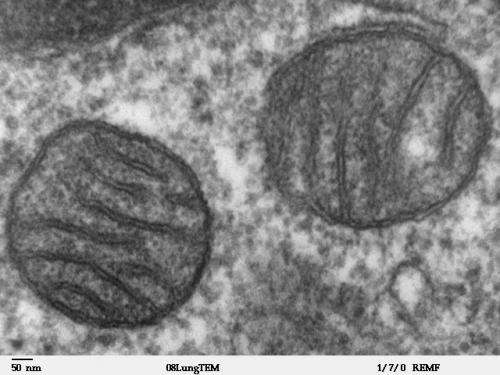April 3, 2013 report
Mitochondrial dynamics in neurons: Whats all the fuss about?

(Medical Xpress)—In the epic series Star Wars, the mysterious energy field known simply as, the Force, was communicated by microscopic endosymbionts known as midichlorians. Their real world counterparts, the mitochondria, are increasingly seen as the main players in almost all of the important functions of a cell. In his popular 2005 book, Power, Sex, Suicide: Mitochondria and the meaning of Life, Nick Lane established that the need for genetic error correction in mitochondria belies much of their seemingly inexhaustible obsession with fission, fusion, and apoptosis. A paper just published in the Journal of Cell Science by a group in Estonia has applied automated tracking techniques to put some real numbers on all this mitochondrial fuss and maneuver, and gives us some insight as to what might be going on inside the cell.
Mitochondria lead what one might describe as an average life in most cells, providing locally-sourced power and other products, or just simply hanging around buffering calcium. It is only within the unique morphology of neurons that the full complexity of their operations comes into its own. Ceaselessly navigating the byways of this sculpted lipid antfarm, mitochondria pause only to fuse, divide, or take themselves out of the game entirely by hooking up with lysosomes. Far from being random, the new research shows that these activities follow balanced cycles, with fission predictably following on the heels of fusion as conditions necessitate. Protein handshakes, the local molecular facilitators of these events, play their part, but the dominant factors are the statistics of mitochondrial size, position, and mobility.
The main findings of the paper can be distilled into a few simple axioms. Probability of fission is determined by mitochondrial length, and probability of fusion is determined by motility. Fusion and fission are cyclically linked and driven by length changes. On the molecular end, it was also shown that impairing motility by overexpressing Tau or 102Q Htt (Huntingtin) proteins suppresses fusion and leads to shortening. Similarly, increasing motility by overexpressing Miro-1 restores fusion rates and size.
Mitochondria often encounter each other within axons barely wide enough to accommodate them. They may then go their own ways without a fusion / fission cycle, making the detection of actual fusion a bit complicated. To make this identification rigorous the researchers labelled mitochondria with mito-Kikume-Green, which can be photactivated by laser to mito-Kikume-Red. When a red and a green mitochondria fuse and exchange matrix material, they turn yellow within about 10 seconds, and are therefore easily detected.
The researchers worked with both cultured cortical and cerebellar granule cells. They were able to track 42 mitochondrial families up to the point where one of the daughters fused. Additionally, 30 families were tracked up to a second fusion. They found that the average length of the daughter undergoing a second fission was greater than twice the length of its nonfissing twin. The fusion rate generally matched the fission rate very closely. In the cortical neurons, these rates were around 0.046 events/mitochondria/min, while in cerebellar granule neurons, the rates were slightly higher.
The mean time interval between fusion and fission was 4.7 min, which was significantly shorter than the interval between fission and the next fusion, 15.3 min. The duration of the entire cycle was therefore approximately 20 min. It should be noted that this analysis was only applied to an active subpopulation of mitochondria, which may explain why the cycle duration found here was shorter than that calculated from the fusion or fission rates of the total mitochondrial population which was closer to 40 min.
The above data give us some idea of just how dynamic these organelles are. It had been observed previously that mutant Huntingtin alters the balance between fission and fusion and that this is a likely cause of neural injury. Mutant Huntingtin has also been shown to trigger mitochondrial fragmentation. Other diseases like optic atrophy and Charcot-Marie-Tooth type 2A have been linked to failure of fusion-fission dynamics. Further studies which take a closer look at other molecular players involved in different mitochondrial activities will refocus many disease efforts onto these remarkable organelles.
More information: Principles of the mitochondrial fusion and fission cycle in neurons Advance Online Article, March 22, 2013, doi:10.1242/jcs.118844 . jcs.biologists.org/content/ear … /jcs.118844.abstract
Abstract
Mitochondrial fusion-fission dynamics play a crucial role in many important cell processes. These dynamics control mitochondrial morphology, which in turn influences several important mitochondrial properties including mitochondrial bioenergetics and quality control, and it appears to be affected in several neurodegenerative diseases. However, an integrated and quantitative understanding of how fusion-fission dynamics controls mitochondrial morphology has not yet been described. Here, we took advantage of modern visualisation techniques to provide a clear explanation of how fusion and fission correlate with mitochondrial length and motility in neurons.
Our main findings demonstrate that: 1) the probability of a single mitochondrion fissing is determined by its length; 2) the probability of a single mitochondrion fusing is determined primarily by its motility; 3) the fusion and fission cycle is driven by changes in mitochondrial length and deviations from this cycle serves as a corrective mechanism to avoid extreme mitochondrial length; 4) impaired mitochondrial motility in neurons overexpressing 120Q Htt or Tau suppresses mitochondrial fusion and leads to mitochondrial shortening whereas stimulation of mitochondrial motility by overexpressing Miro-1 restores mitochondrial fusion rates and sizes.
Taken together, our results provide a novel insight into the complex crosstalk between different processes involved in mitochondrial dynamics. This knowledge will increase understanding of the dynamic mitochondrial functions in cells and in particular, the pathogenesis of mitochondrial-related neurodegenerative diseases.
© 2013 Medical Xpress













